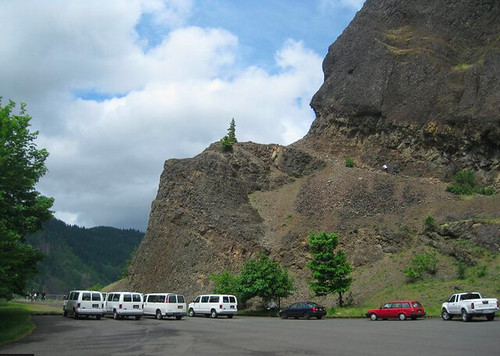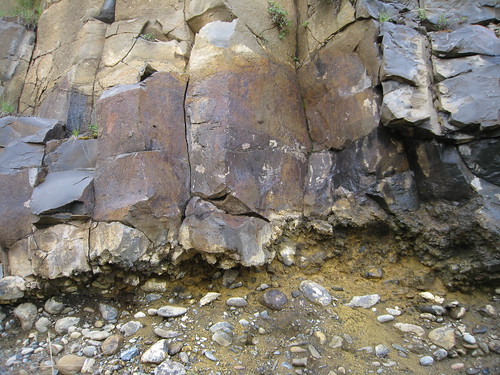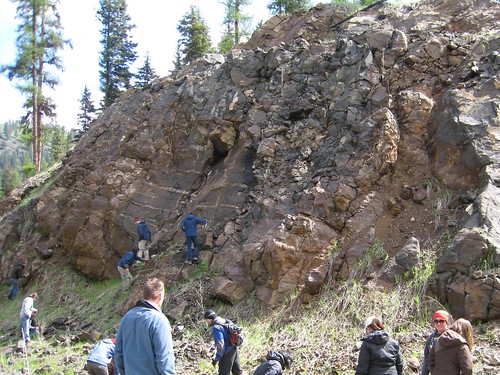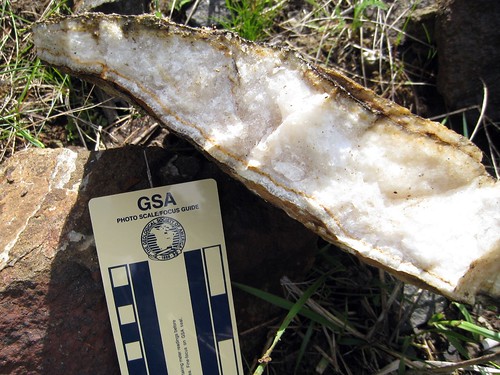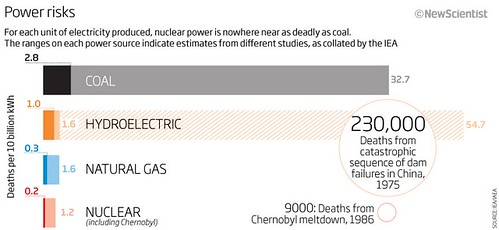Some Eastern Oregon geology fun.
My petrology class recently spent a weekend in the Blue Mountains learning how to hit rocks and write notes in the rain. Okay, so it was a little more than just that. Being a geologist requires the ability to look around and think of things on an incredibly macro scale: area, depth, and (especially) time. Sometimes it's astounding to realize just how big the Earth is... I don't even need the stars to feel insignificant. The beginning of the trip entailed four hours of driving from Portland to La Grande, alongside nothing but Columbia River Basalts. Four hours! You can hardly imagine how much volcanism must have been going on to produce such large deposits.
I'll spend the next few posts describing our field trip and the geology of Eastern Oregon. Click here for a Google Earth (best freeware ever made!) map of the first nine stops.
Stop 1
Observations: A large, well-formed columnar basalt layer had been deposited over a layer of rounded cobbles and clay. The basalt contains a lot of vesicles and olivine phenocrysts, while the cobbles are mostly Columbia River Basalts (CRB) and various metamorphic rocks. The border between the two strata is rough and contains palagonite, an indication of altered glass. (This is unusual! Basalt has such a low viscosity that it doesn't normally prefer to create glass.)
The outcrop is nestled in a valley with Grande Ronde Basalt (dated at 15 Ma) on either side and the modern Grande Ronde River flowing nearby. Its surrounding rocks are distinctly different, most noticeably by the absence of olivine phenocrysts.
Interpretations: After the Grande Ronde basalt was formed about 15 million years ago, a river cut through the rock and created a valley. The cobbles match metamorphic rocks associated with Oregon's mass amounts of accreted terrane, so they were probably eroded and carried down the river from a highland outcrop somewhere nearby. Around 10 Ma, a basalt lava flow (maybe from the Powder River Volcanics?) suddenly filled in the valley and was allowed to cool slowly and cohesively, giving it distinct columnar jointing and a high density. The hot lava interacted with the river water to create glass, which is why we found palagonite present at the contact zone.
Stop 2
Observations: There are coarser, crystalline rocks that form bands within a basaltic mass. The thinner bands have more vesicles but are texturally similar. The banding does not show any evidence of chilled margins, indicating that it was not a sill intrusion. Nicely-formed quartz and calcite veins solidified in the cooling cracks of the basalt.
Interpretations: This basalt flow is probably older than the CRBs since the growth of quartz and calcite as secondary minerals would have taken longer to form. Basalt can contain up to 10% calcium, so weathering processes likely caused the calcite to precipitate into cracks that formed as it was cooling. Later, hydrothermal fluids rising through the cracks would have carried dissolved SiO2 and created the quartz veins. This outcrop is estimated to have formed at around 28 Ma.
TO BE CONTINUED...
6.04.2011
5.13.2011
Know a Fossil: RUGOSA
Posted by
Stacy P
at
7:24 PM
Digging up and dissecting the Earth's hidden treats.
Taxonomy
Kingdom: Animalia
Phylum: Cnidaria
Class: Anthozoa
Subclass: Zoantharia
Order: Rugosa
Etymology
Rugose coral found a namesake in the Latin word for wrinkled (rug- or rugo-), due to their characteristically ridged outer surface. However, the distinct shape of their coral structure gave rise to a more commonly used name of “horn coral.” Older paleontology articles, especially from the late 1800s, often cite these organisms as tetracoralla in reference to the corals’ tendency to insert septa in groups of four.
Index Fossils
Rugosa first appeared in the mid-Ordovician (about 465 Ma) and disappeared at the end of the Permian (about 250 Ma). Because of the occurrence of the mass Permian-Triassic extinction, there are no known direct descendants of rugose corals. However, it is thought that rugose polyps had arms full of stinging cells that helped to catch prey, which is a common characteristic found in modern corals. Rugosa’s relatively short existence, combined with their distinct characteristics and worldwide geographic spread makes them excellent index fossils.
Morphology
All horn corals live inside of a “cup” called the calyx, a basin-shaped depression within a hard outer sleeve (or theca). The polyp builds these encasings by secreting calcite to add a new layer of growth each day that it is alive. A distinct characteristic of Rugosa is found inside the calyx, where radially-aligned septa extend inward from the outer wall. These features serve as skeletal support plates for the polyp.
The theca is built in (what humans would call) an inverse fashion, with the point of the horn at the bottom and the wide, open end at the top. Inside the base of the theca, transverse partitions form shelf-like structures called tabulae. They form one by one as the polyp pulls itself upward, until it rests on top of the skeleton with its arms pointing toward the open ocean. This growth mechanism means they can get to be a wide range of sizes, from a few millimeters long to over one full meter.
The arrangement of a rugose coral’s septa is very important for classifying its type. While solitary horns will nearly always have septa in groups of four, the colonial corals usually develop in multiples of 6 – all of which grow in varying patterns depending on what stage of life the coral is at.
Lifestyle
Rugosa were usually solitary creatures, though some could be found in colonial masses with a more hexagonal coral structure. They attached themselves to the seafloor with rudder-like talons while the polyp (sitting atop the horn) used tentacles that swept in the ocean currents to catch organisms for feeding. Although some horn corals reproduced sexually, it was more common for budding to occur, a type of asexual reproduction. The buds consist of four septa that spread apart as they grew, until new septa were added to maintain the coral’s rigid structure. The parent polyp then split off new polyps to create separate corallites.
Colonial masses would grow as individuals banded together. However, even then rugose corals were rarely reef-builders like the corals known today. Standing up on end meant that it was relatively easy for ocean currents to knock the animal over, and they would have to build a new calyx within the old one to “upright” itself. This resulted in fossils with an awkwardly twisted, cup-in-cup shape. To accommodate for this inconvenience, it’s likely that solitary corals colonized soft bottom environments by sinking their points into the soft sediment.
Rugosa fossils have been found in all four types of reef areas (fore-reef, reef, back-reef, and bioherms), usually in carbonate rocks. Studies indicate that they lived in tropical shallow seas, generally very close to the continental shelf, and preferred clear, high-energy waters that were well oxygenated.
Printable Versions:
Taxonomy
Kingdom: Animalia
Phylum: Cnidaria
Class: Anthozoa
Subclass: Zoantharia
Order: Rugosa
Etymology
Rugose coral found a namesake in the Latin word for wrinkled (rug- or rugo-), due to their characteristically ridged outer surface. However, the distinct shape of their coral structure gave rise to a more commonly used name of “horn coral.” Older paleontology articles, especially from the late 1800s, often cite these organisms as tetracoralla in reference to the corals’ tendency to insert septa in groups of four.
Index Fossils
Rugosa first appeared in the mid-Ordovician (about 465 Ma) and disappeared at the end of the Permian (about 250 Ma). Because of the occurrence of the mass Permian-Triassic extinction, there are no known direct descendants of rugose corals. However, it is thought that rugose polyps had arms full of stinging cells that helped to catch prey, which is a common characteristic found in modern corals. Rugosa’s relatively short existence, combined with their distinct characteristics and worldwide geographic spread makes them excellent index fossils.
All horn corals live inside of a “cup” called the calyx, a basin-shaped depression within a hard outer sleeve (or theca). The polyp builds these encasings by secreting calcite to add a new layer of growth each day that it is alive. A distinct characteristic of Rugosa is found inside the calyx, where radially-aligned septa extend inward from the outer wall. These features serve as skeletal support plates for the polyp.
The theca is built in (what humans would call) an inverse fashion, with the point of the horn at the bottom and the wide, open end at the top. Inside the base of the theca, transverse partitions form shelf-like structures called tabulae. They form one by one as the polyp pulls itself upward, until it rests on top of the skeleton with its arms pointing toward the open ocean. This growth mechanism means they can get to be a wide range of sizes, from a few millimeters long to over one full meter.
The arrangement of a rugose coral’s septa is very important for classifying its type. While solitary horns will nearly always have septa in groups of four, the colonial corals usually develop in multiples of 6 – all of which grow in varying patterns depending on what stage of life the coral is at.
Lifestyle
Rugosa were usually solitary creatures, though some could be found in colonial masses with a more hexagonal coral structure. They attached themselves to the seafloor with rudder-like talons while the polyp (sitting atop the horn) used tentacles that swept in the ocean currents to catch organisms for feeding. Although some horn corals reproduced sexually, it was more common for budding to occur, a type of asexual reproduction. The buds consist of four septa that spread apart as they grew, until new septa were added to maintain the coral’s rigid structure. The parent polyp then split off new polyps to create separate corallites.
Colonial masses would grow as individuals banded together. However, even then rugose corals were rarely reef-builders like the corals known today. Standing up on end meant that it was relatively easy for ocean currents to knock the animal over, and they would have to build a new calyx within the old one to “upright” itself. This resulted in fossils with an awkwardly twisted, cup-in-cup shape. To accommodate for this inconvenience, it’s likely that solitary corals colonized soft bottom environments by sinking their points into the soft sediment.
Rugosa fossils have been found in all four types of reef areas (fore-reef, reef, back-reef, and bioherms), usually in carbonate rocks. Studies indicate that they lived in tropical shallow seas, generally very close to the continental shelf, and preferred clear, high-energy waters that were well oxygenated.
Rugosa Bibliography.pdf
Bibliography
- Carlson, R. and Poor, J. (2005). Historical Geology: Interpretations and Applications. Upper Saddle River: Pearson Education, Inc.
- Clarkson, E. N. K. (1998). Invertebrate Paleontology and Evolution. Malden: Blackwell Science Ltd.
- Doyle, P. (1996). Understanding Fossils: An Introduction to Invertebrate Paleontology. West Sussex: John Wiley and Sons Ltd.
- Haeckel, E. (1998). Art Forms in Nature. New York: Prestel.
- Kentucky Geological Survey. (2006). Rugose Corals. Retrieved May 3, 2011 from http://www.uky.edu/KGS/fossils/rugosecorals.htm
- Levin, H. (1999). Ancient Invertebrates and their Living Relatives. Upper Saddle River: Prentice-Hall, Inc.
- White, T. et. al. (2010). Rugosa. Retrieved May 7, 2011 from http://www.palaeos.org/Rugos
4.18.2011
The Beauty of Being Calm
Posted by
Stacy P
at
10:02 PM
This was filmed between 4th and 11th April 2011.
4.14.2011
Mineral Discovery
Posted by
Stacy P
at
12:34 PM
A new mineral, dubbed "Wassonite" to honor UCLA's main meteorite researcher John T. Wasson, was officially announced by NASA on April 5, 2011. It was found via electron microscope in an Antarctic meteorite that's been sitting around since the Japanese Antarctic Expedition Team (JARE) first brought it home in 1969! This discovery is generally no big thing, seeing as around 50 new minerals are approved by the International Mineralogical Association (IMA) each year... but this one is special. It's made up of two elements arranged in a crystal structure never before observed in nature - titanium (II) sulfide, or TiS, was previously known only as a synthetic compound.
The tiny, tiny specks of Wassonite were surrounded by more mystery minerals, which researchers are currently looking into.
The tiny, tiny specks of Wassonite were surrounded by more mystery minerals, which researchers are currently looking into.
4.12.2011
Psh, That's Old News
Posted by
Stacy P
at
12:23 PM
Progressions of knowledge through time.
April 12 seems to be an active day for scientific advancement! Let's take today's Google Doodle one step further and look through a few of the date's historical moments:
 April 12, 1888:
April 12, 1888:
A french newspaper mistakenly reported, "Dr. Alfred Nobel, who became rich by finding ways to kill more people faster than ever before, died yesterday." But Alfred wasn't dead... his brother was! The erroneous article that insulted him for the invention of dynamite made him wonder how his name would be remembered for the rest of civilization - thus, the birth of the Nobel Prize.
 April 12, 1955
April 12, 1955
Dr. Thomas Francis, Jr. announced that Jonas Salk's vaccine against polio was verified to be "safe, effective, and potent." The statement was made at a University of Michigan press conference, to highlight the 10th anniversary of Franklin Roosevelt's death from the disease. Salk, however, stole the stage by defying Dr. Francis's description of testing problems and insisted that he had created nothing less than the perfect vaccine. There's an accurate write-up of the incident in the U of M history files.
 April 12, 1961
April 12, 1961
Russian pilot Yuri Gagarin became the first human in space. He orbited the Earth in 108 minutes aboard the Vostok 1, a completely automated spacecraft. (The controls ran on automatic for the duration of the flight, though there was a sealed envelope containing a key in case of an emergency.) Instead of landing "the normal way," Gagarin made a pre-planned descent by ejecting the spacecraft and floating down to land via parachute. The vessel was spherical and not designed to safely land with a human still on board. The Soviet Union denied this action for several years in order to evade the FAI world records rules, which states that a pilot must accompany his craft to a landing.
 April 12, 1981
April 12, 1981
American Space Shuttle Columbia was launched. This was the first successful reusable spacecraft developed by NASA. It went on to complete a total of 28 flights, spent 300.74 days in space, completed 4, 808 orbits, and flew over 200,000,000 km.
 April 12, 1994
April 12, 1994
Attourney Laurence Canter created the first commercial internet spamming program to solicit business for his law firm on a message board. Need I say more? Read more about how this annoying sludge got started on Wired.
Interesting Fact: The term "spam" is from the BBC television series Monty Python's Flying Circus. There is a sketch in the show where a waitress offers an unwilling patron a menu with nothing but variations of spam on it.
April 12 seems to be an active day for scientific advancement! Let's take today's Google Doodle one step further and look through a few of the date's historical moments:
 April 12, 1888:
April 12, 1888:A french newspaper mistakenly reported, "Dr. Alfred Nobel, who became rich by finding ways to kill more people faster than ever before, died yesterday." But Alfred wasn't dead... his brother was! The erroneous article that insulted him for the invention of dynamite made him wonder how his name would be remembered for the rest of civilization - thus, the birth of the Nobel Prize.
 April 12, 1955
April 12, 1955Dr. Thomas Francis, Jr. announced that Jonas Salk's vaccine against polio was verified to be "safe, effective, and potent." The statement was made at a University of Michigan press conference, to highlight the 10th anniversary of Franklin Roosevelt's death from the disease. Salk, however, stole the stage by defying Dr. Francis's description of testing problems and insisted that he had created nothing less than the perfect vaccine. There's an accurate write-up of the incident in the U of M history files.
 April 12, 1961
April 12, 1961Russian pilot Yuri Gagarin became the first human in space. He orbited the Earth in 108 minutes aboard the Vostok 1, a completely automated spacecraft. (The controls ran on automatic for the duration of the flight, though there was a sealed envelope containing a key in case of an emergency.) Instead of landing "the normal way," Gagarin made a pre-planned descent by ejecting the spacecraft and floating down to land via parachute. The vessel was spherical and not designed to safely land with a human still on board. The Soviet Union denied this action for several years in order to evade the FAI world records rules, which states that a pilot must accompany his craft to a landing.
“I could have gone on flying through space forever.” - Yuri Gagarin
 April 12, 1981
April 12, 1981American Space Shuttle Columbia was launched. This was the first successful reusable spacecraft developed by NASA. It went on to complete a total of 28 flights, spent 300.74 days in space, completed 4, 808 orbits, and flew over 200,000,000 km.
 April 12, 1994
April 12, 1994Attourney Laurence Canter created the first commercial internet spamming program to solicit business for his law firm on a message board. Need I say more? Read more about how this annoying sludge got started on Wired.
Interesting Fact: The term "spam" is from the BBC television series Monty Python's Flying Circus. There is a sketch in the show where a waitress offers an unwilling patron a menu with nothing but variations of spam on it.
4.07.2011
Perceptions on Meltdown
Posted by
Stacy P
at
12:59 PM
Radiation can be scary, whether you're looking at its effects under the microscope or in a post-apocalyptic full-length feature film. But people accept radiation into their bodies in all types of forms - eating a banana, tanning in the summer sun, and of course getting an x-ray at the hospital. The hype from the Fukushima Daiichi nuclear plant leak is causing a completely unprecedented political and social "scare" thanks to public ignorance on the subject. Here are two items that help put things into perspective:
Subscribe to:
Posts (Atom)

